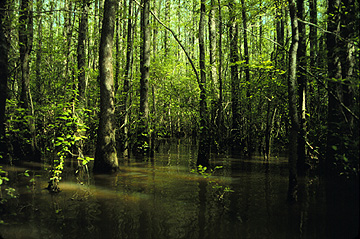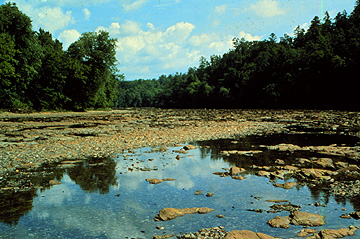'Natural variability' is key to river restoration and conservation, experts agree
By Roger Segelken
Managing a river to maintain minimum water flow or sustain a single "important species" is like teaching pet tricks to a wolf: The animal may perform, but it's not much of a wolf anymore.
That is the conclusion of a six-university panel of river experts whose report, "The Natural Flow Regime: A Paradigm for River Conservation and Restoration," is published in the December 1997 issue of the journal BioScience (Vol. 47, pp. 769-784). Letting a river do its own thing -- come drought or high water -- is more complicated than anyone realized until recently, the panel agrees, but at least scientists now know why natural flow is important and how to help.
"People say you can never return the Ohio River to its natural state, and you can't -- without displacing a lot of people," said Mark B. Bain, a fish ecologist at Cornell University and one of eight authors of the BioScience report. "But you can enhance different portions of the Ohio's flow regime, by changes to dams and water-use operations, for example, and return some of the ecological integrity with relatively minor changes," he said.
"It is now clear that natural river systems can and should be allowed to repair and maintain themselves," said N. LeRoy Poff, a biologist at Colorado State University. "Every river system is different, and each will take a different mix of human-aided and natural recovery methods. But the key to management of healthy river ecosystems has to revolve around restoring their natural dynamic character."
The river system study was funded by a grant from the George Gund Foundation, with logistical support from The Nature Conservancy. Participating in the study were Bain, an associate professor of natural resources at Cornell; Poff, an assistant professor of biology, Colorado State; J. David Allan, professor of natural resources, University of Michigan; James R. Karr, professor in the departments of fisheries and zoology, University of Washington; Karen L. Prestegaard, associate professor of geology, University of Maryland; Brian D. Richter, hydrologist for the Nature Conservancy; Richard E. Sparks, director of river research, Illinois Natural History Survey; and Julie C. Stromberg, associate professor of plant biology, Arizona State University.


The scientists said there's more to natural flow than tolerating the occasional "100-year flood" or creating human-made floods. They identified five often overlooked components of a river's flow regime (magnitude, frequency, duration, timing and rate of change), saying: "Modification of flow has cascading effects on the ecological integrity of rivers." (See "summary points," attached)
Cornell ecologist Bain cited five examples of American rivers that still run free, and four that could with a little help:
-- Cahaba River (Alabama) "Undammed, with no major water withdrawals, this is one of the country's most species-diverse rivers."
-- Yampa (Colorado) and Little Colorado (Arizona): "The last rivers supporting the largely exterminated fishes of the Colorado River system."
-- Hudson River (New York, New Jersey): "A lot of diversity for a river that flows through the most densely populated region in the U.S." Because the lower Hudson never had controlled flows, Bain said, the river remains a stronghold for many Atlantic Coast migratory fishes.
-- French Creek (river-sized system in New York and Pennsylvania): "Retaining its record-high diversity of fish and mussels, this large stream holds species that used to be in the Allegheny River prior to dams."
-- Mohawk River (New York): "Dammed, channelized and almost entirely controlled, the Mohawk River is now dominated by hearty, non-native species and recreational boats."
-- Columbia River (Washington, Oregon): "Despite intense public interest, a major salmon industry and hundreds of millions of dollars annually devoted to mitigation, restoring the river's famous fish runs hasn't worked ."
-- Colorado River (Arizona, Utah, Colorado): "The original fish fauna have disappeared and many other organisms in the native community are nearly extinct." However, all the human demands for the Colorado's water probably preclude major changes in river management, Bain said, adding: "Fortunately, Grand Canyon looks fine without water; it's a good thing it's supposed to be arid."
-- Kissimmee River (Florida) "By dismantling flood-control dams and connecting with swamps and wetlands, the largest ecosystem restoration effort in U.S. history will return this river to its winding, swampy path and greatly increase water quality."
The river scientists said they hoped the report -- by presenting state-of-the-art knowledge about the importance of natural variability to aquatic and riparian ecosystems -- will help river managers and agencies make the argument that unfettered rivers have multiple benefits for nature and for human society.
-30-
Summary Points
"The Natural Flow Regime: A Paradigm for River Conservation and Restoration"
BioScience, Vol. 47, pp. 769-784 (December 1997)
-- River ecosystems are damaged and degraded due to multiple human actions. Changes to the natural flow regime constitute one particularly important and underappreciated cause of declining health of rivers.
-- Natural variability characterizes all ecosystems. Variability in river flow is a prime example of such natural variability. Each river has a natural flow regime, which can be altered by a variety of human actions including dams, diversions and diverse ways in which hydrologic pathways are altered.
-- Natural variability in river flow creates a wide range of habitat types and ecosystem processes that maintain the natural biological diversity of aquatic and riparian (stream side) species. A major consequence of this natural variability is that all species experience favorable conditions at some time, preventing any one species from dominating.
-- Alterations of the natural flow regime result in numerous physical, chemical and biological changes to river ecosystems. Examples include not just salmon migrations but recruitment of riparian trees, maintenance of sandbars in river channels, and sustenance of wetland habitat dependent upon flood plain inundation.
-- Scientific knowledge allows us to characterize the natural flow regime of a river and determine the extent to which it has been altered. Our understanding of the linkages between natural flow regime and the ecological functioning of rivers provides a powerful scientific basis for river management and restoration.
-- Current river management too often fails to consider the importance of natural variability. The standard practice of managing for one or a few "important" or imperiled species by defining how little water can be left in the river is not adequate based on new scientific understanding. Some examples of restoring the natural flow regime (e.g. Glen Canyon) provide encouragement that the adaptive management approaches can be used to manage for whole river ecosystems.
Media Contact
Get Cornell news delivered right to your inbox.
Subscribe